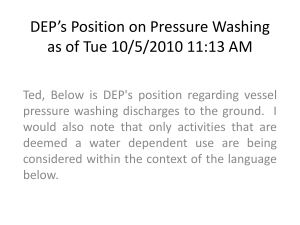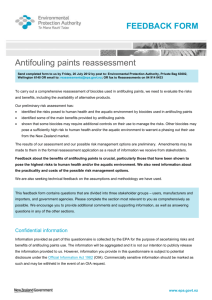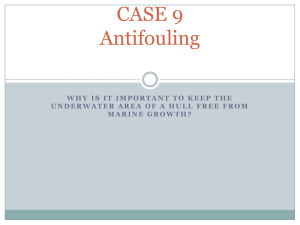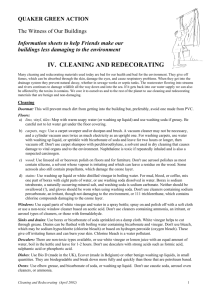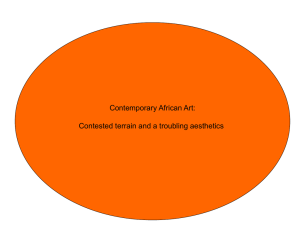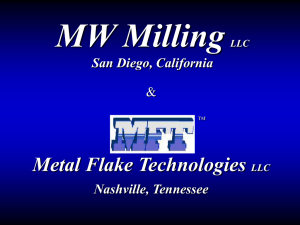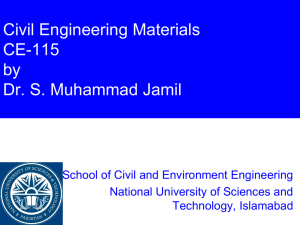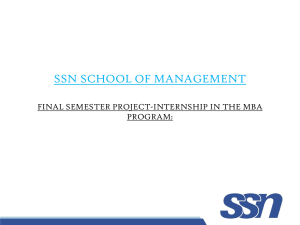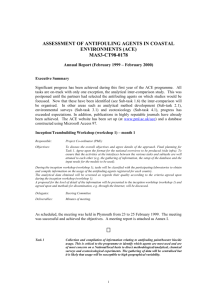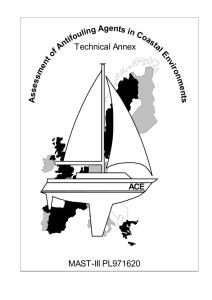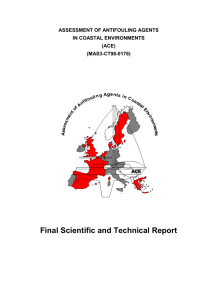EAI 1_2014.indd
advertisement
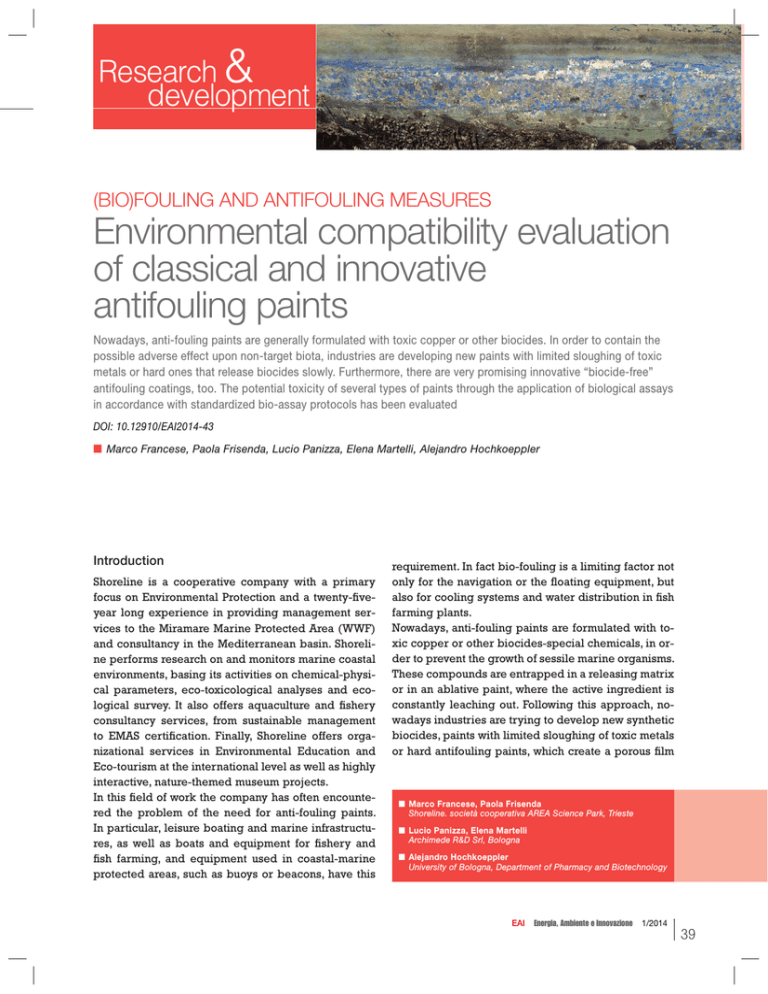
Research & development (BIO)FOULING AND ANTIFOULING MEASURES Environmental compatibility evaluation of classical and innovative antifouling paints Nowadays, anti-fouling paints are generally formulated with toxic copper or other biocides. In order to contain the possible adverse effect upon non-target biota, industries are developing new paints with limited sloughing of toxic metals or hard ones that release biocides slowly. Furthermore, there are very promising innovative “biocide-free” antifouling coatings, too. The potential toxicity of several types of paints through the application of biological assays in accordance with standardized bio-assay protocols has been evaluated DOI: 10.12910/EAI2014-43 ■ Marco Francese, Paola Frisenda, Lucio Panizza, Elena Martelli, Alejandro Hochkoeppler Introduction Shoreline is a cooperative company with a primary focus on Environmental Protection and a twenty-fiveyear long experience in providing management services to the Miramare Marine Protected Area (WWF) and consultancy in the Mediterranean basin. Shoreline performs research on and monitors marine coastal environments, basing its activities on chemical-physical parameters, eco-toxicological analyses and ecological survey. It also offers aquaculture and fishery consultancy services, from sustainable management to EMAS certification. Finally, Shoreline offers organizational services in Environmental Education and Eco-tourism at the international level as well as highly interactive, nature-themed museum projects. In this field of work the company has often encountered the problem of the need for anti-fouling paints. In particular, leisure boating and marine infrastructures, as well as boats and equipment for fishery and fish farming, and equipment used in coastal-marine protected areas, such as buoys or beacons, have this requirement. In fact bio-fouling is a limiting factor not only for the navigation or the floating equipment, but also for cooling systems and water distribution in fish farming plants. Nowadays, anti-fouling paints are formulated with toxic copper or other biocides-special chemicals, in order to prevent the growth of sessile marine organisms. These compounds are entrapped in a releasing matrix or in an ablative paint, where the active ingredient is constantly leaching out. Following this approach, nowadays industries are trying to develop new synthetic biocides, paints with limited sloughing of toxic metals or hard antifouling paints, which create a porous film ■ Marco Francese, Paola Frisenda Shoreline. società cooperativa AREA Science Park, Trieste ■ Lucio Panizza, Elena Martelli Archimede R&D Srl, Bologna ■ Alejandro Hochkoeppler University of Bologna, Department of Pharmacy and Biotechnology EAI Energia, Ambiente e Innovazione 1/2014 39 on the surface where biocides are held and released slowly. But there are also very promising alternative ways for innovation. Non-toxic silicon coatings produce slick surfaces where fouling growth cannot attach, but the critical issue is that they do not last long. Other innovative antifouling coatings use fluoropolymers or biodegradable polymers, or are made of a biocide-free epoxy resin. High-tech antifouling coatings are the amphiphilic/hybrid systems or the surface created with micro-topography. However, considering the environmental impact of traditional antimicrobials, alternative antifouling strategies were recently considered [1]. In particular, the addition of antimicrobial nanoparticles or enzymes to paints has also been investigated. In our case study the active component, which was the subject of the experimentation carried out by Shoreline, was a paint-entrapped enzyme (also defined active compo- EAI 40 Energia, Ambiente e Innovazione 1/2014 FIGURE 1 Results (expressed as growth rate %) of the algal bioassays on various classical anti-fouling paints by leaching protocol nent), without chemical bonds with the resin. Active component does not contain any heavy metals, nor other substances which, according to the current definition, are listed in the Biocides Directive (Directive 98/8/EC). The biocomponent-based antifouling paint can alter physical and chemical natural parameters all around the hull, taking advantage of substances present in the environment, according to the principle: produce in situ what you need and when you need it. The researcher has indeed considered that a microeffervescence produced by a treated surface would physically (mechanically) and chemically (indirectly) inhibit the colonization by microorganisms. In recent years, only some environmentally-friendly materials, such as wood [2] and concrete for urban building [3] and road maintenance [4-5], have been tested for the possible direct effects on the environment. With regard to the “biocide-free” anti-fouling paints, a lot of research and experimental procedures have been carried out to demonstrate whether they are toxic or not [6-10], but no unanimous protocols have been developed yet, in order to assess whether they are completely non-hazardous for the environment [11]. The main purpose of this preliminary work was to evaluate the potential toxicity of several types of paints through the application of biological assays in accordance with standardized bio-assay protocols. Research & development FIGURES 2 AND 3 Results day by day (expressed as growth rate %) of the algal bioassays on innovative paints by leaching protocol and by direct contact protocol Materials and methods The study was carried out both on paintings that could be defined as classic and on innovative antifouling paintings. The containers used for the tests were 500 mL glass beckers. The media used for antifouling paints were fibreglass slides 5 cm long and 5 cm wide, with a specific primer for each paint. The specimens are described as follows: • VER_01 INNOVATIVA (acrylic resin matrix, transparent) • VER_02 (hard matrix, high percentage in copper oxide, water-based, coloured) • VER_03 (ablative, low percentage in zinc oxide, coloured) • VER_04 (hard matrix, high percentage in zinc oxide, coloured) • VER_05 (ablative, medium percentage in copper oxide and zinc oxide, coloured) • VER_06 (hard matrix, medium percentage in copper oxide and low percentage in zinc oxide, coloured) The leaching protocol included an extraction time of 24 hours on an orbital shaker, at 20 ± 2°C (Ecotox Ecotherm 80), and the leaching solution (natural seawater filtered 0.45 microns (Millipore)) was not renewed. In the case of VER_01 INNOVATIVA paint, in addition to the leaching protocol, during the 96h algal test the sample was left inside a becker and submerged in a solution where unicellular seaweeds were inoculated, following a direct contact protocol (Prova-1). The eco-toxicological assays that were applied are (i) the 96h growth inhibition using Phaeodactylum tricornutum Bohlin 1897 (Bacillariophyceae, Naviculales) (ISO 10253:2006), and (ii) the 48h mortality rate using Artemia franciscana Kellogg 1906 (Crustacea, Branchiopoda), as 2nd and 3rd nauplius stages (APATIRSA-CNR 2003 n. 8060). The target species and protocols chosen for the biological assays, were not the ones generally used to evaluate the effectiveness of antifouling paints, but they were the standard ones used for the evaluation of the pollutants toxicity in the natural environment. In this trial soft changes to the protocol were adopted since no toxicity of contaminated solutions was evaluated, but the physical FIGURE 4 Long-term activity extrapolation of active component activity in a seawater solution EAI Energia, Ambiente e Innovazione 1/2014 41 Research & development FIGURES 5 AND 6 Activity of active component (ISE electrode method) both in solution and entrapped on resin, compared to control (mechanical) and chemical (indirectly) effects of the active component. In addition, the active component stability and acti- vity were tested both in a seawater solution and, after entrapment, in a water-based contaminant-free polymeric resin (Crilat 4816-Vinavil) spread on fiberglass slides. The analyses have been carried out using spectrophotometric techniques (Uvikon 923 UV/VIS) and gas sensitive electrodes (CyberScan pH 2100 BenchMeter - Eutech Instruments, with ionoselective membrane Mettler Toledo). Results First of all, the comparison of the 2 bioassays that we chose to perform on classical anti-fouling paints has highlighted that Artemia did not show any differential effect, being non-toxic in all cases, whereas unicellular seaweeds were more sensitive, showing a differential toxic effect. Different growth inhibitions were observed, related to concentration of leachate: strong inhibition with whole sample (C5 100%) (Figure 1). Conversely, in the innovative paint sample only an initial inhibition of algal growth rates was observed, but the final growth rates were subsequently comparable in the experimental and the control slides. During the experiment the algae were exposed both to leaching sample (Leaching) and to direct contact sample (Prova-1) over a period of 96 hours. Indeed, focusing the discussion on the rate of growth related to the whole sample (C5 100%) in the P. tricornutum assay (Figures 2 and 3), growth inhibition was observed during the EAI 42 Energia, Ambiente e Innovazione 1/2014 ref erences Conclusions According to these results, we can conclude that the use of bioassays to test non-releasing and non-toxic innovative paints is nonetheless valid, although some changes in the exposition protocols, as well as complementary data for result interpretation, are required. However, since the A. franciscana assay - which is commonly used to test the efficacy of anti-fouling paints [12] – appeared to be definitely less sensitive than the algal assay with P. tricornutum, we plan to carry out further experiments using different types of assays on target and non-target species. With regard to the enzyme-based paints, we can conclude that this first set of experiments have shown that the new product, which is active and stable for a considerably long time, does not induce sub-chronic toxicity. Further and innovative efficacy and resistance tests will be developed. ● Research & development first 48h of exposure. In particular, after 24h there was a 35% decrease in the leaching sample (Leaching) and a 54% decrease if observing the results of direct contact protocol experiment (Prova-1), both compared to the control. After 48h, a decrease of about 10% was observed in both cases. After 72h and 96h, growth rates were similar to the control or even higher, with differences of about 5-10%. Such results could not be associated to an active component inactivation, since data on active component activity were also gathered for a seawater solution and a long-term activity. By the data extrapolation carried out, the activity duration was estimated to be of about 6 months (Figure 4). In addition, it was shown that after entrapment in resin the active component remained active and generated micro-effervescence, whereas this effect was observed as a lower rate in the control (Figures 5 and 6). 1. 2. Faimali M., Piazza V., Geraci S. (2001), “Natural antifouling products: new technologies, old problems”, European Coatings, num. 17, vol. 77: 59-64. Libralato G., Marchetto D., Losso C., Arizzi Novelli A., Tagliapietra D.e Volpi Ghirardini A. (2006), “I lisciviati del legno: valutazione dei potenziali impatti ecotossicologici sulle acque marine costiere”, Atti del XV Congresso Nazionale della Società Italiana di Ecologia (Torino, 12-14 settembre 2005), S3.11 Ecologia, a cura di Comoglio C. & Comino E. & Bona F. [online] URL: http://www.xvcongresso.societaitalianaecologia.org/articles/Libralato-144.pdf 3. Van der Sloot, H.A. e J.J. Dijkstra (2004). “Development of horizontally standardized leaching tests for construction materials: a material based or released based approach? Identical leaching mechanisms for different materials”, ECN-C-04-060 (project nr. 2003.06.089): 1-56, Dutch Ministry of Housing, Spatial Planning and the Environment (VROM), Soil, Water and Rural Environment Directorate. 4. Nelson P.O., Huber W.C., Eldin N.N., Williamson K.J., Lundy J. R., Azizian M.F., Thayumanavan P., Quigley M.M., Hesse E.T., Frey K.M. e Leahy R.B. (2001). “Environmental Impact of Construction and Repair Materials on Surface and Ground Waters Summary of Methodology, Laboratory Results, and Model Development Transportation research board”, NCHRP Project 25-9 Report 448 National Research Council, vol unico: 1-129, National Academy Press Washington d.c.. 5. Herrington, P., Kvatch I., O’Halloran K. (2004). “Assessing the environmental effects of new and recycled materials in road construction: proposed guidelines”, Transfund New Zealand Research Report, vol. 306: 1-70, Herrington & Kvatch (Opus Central Laboratories) & O’Halloran (Landcare Research Ltd). 6. Piazza V., Ferioli A., Giacco E., Melchiorre N., Valenti A., Del Prete F., Biandolino F., Dentone L., Frisenda P., Faimali M. (2012), “A standardization of Amphibalanus (Balanus) amphitrite (Crustacea, Cirripedia) larval bioassay for ecotoxicological studies”, Ecotoxicol Environ Saf., ed. 2012, vol. 79: 134–138. 7. Faimali M., Garaventa F., Cozzolino D., Romairone V. (2002a), “Efficacy and toxicity of experimental antifouling paints; a multi-bioassays screening (part one)”, European Coatings, num. 10, vol. 78: 7-14. 8. Faimali M., Garaventa F., Cozzolino D., Romairone V. (2002b), “Efficacy and toxicity of experimental antifouling paints; a multi-bioassays screening (part two)”, European Coatings, num. 16, vol. 78: 7-11. 9. Frisenda P., Francese M. (2012), “Protocollo sperimentale per il controllo della compatibilità ambientale di materiali innovativi”, Atti delle Giornate di Studio 5° edizione Livorno 7-9 novembre 2012, Atti 2013: 235-241, ISPRA. 10. Mesaricˇa T., Sepcˇicˇa K., Piazza V., Gambardella C., Garaventa F., Drobnea D. and M. Faimali. (2013), “Effects of nano carbon black and single-layer graphene oxide on settlement, survival and swimming behaviour of Amphibalanus amphitrite larvae”, Chemistry and Ecology 2013, ISSN 1029-0370 (Online), vol. unico: 1-10, Taylor & Francis. 11. Löschau, M. e R. Krätke (2005). “Efficacy and toxicity of self-polishing biocide-free antifouling paints”, Environmental Pollution, vol. 138: 260-267. 12. Persoone, G. e Castritsi-Catharios J. (1988). “A simple bioassay with Artemia larvae to determine the acute toxicity of antifouling paints”, Water research, vol. 23: 893-897. EAI Energia, Ambiente e Innovazione 1/2014 43
